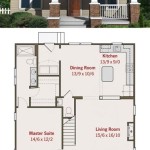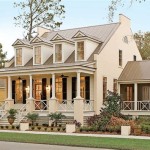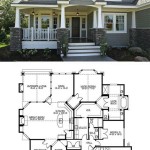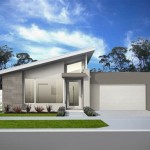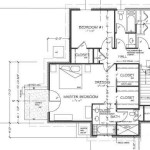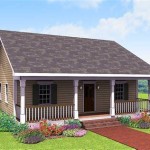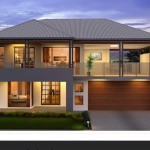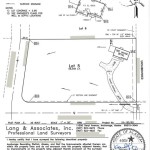3 Bedroom Building Plans With Dimensions: A Detailed Guide
The planning and construction of a 3-bedroom house involves careful consideration of spatial requirements, functionality, and adherence to building codes. Having detailed building plans with dimensions is critical for effective communication between architects, contractors, and homeowners, ensuring that the final structure aligns with expectations and efficiently uses available space. This article provides a comprehensive overview of key aspects involved in 3-bedroom building plans, emphasizing the importance of accurate dimensions and their impact on overall design and construction.
The process begins with the initial concept, driven by the homeowner's lifestyle, budget, and site conditions. This translates into a preliminary floor plan illustrating the arrangement of rooms, including the three bedrooms, living areas, kitchen, bathrooms, and any additional spaces like a study or utility room. The scale of the plan is crucial, as it determines the accuracy of subsequent measurements and calculations. Common scales used include 1:50, 1:100, or 1:200, dictating the representation of real-world measurements on the drawing.
Importance of Dimensional Accuracy in Building Plans
Dimensional accuracy is paramount in building plans. Precise measurements are essential for several reasons. Firstly, it ensures that the structural components, such as walls, beams, and columns, are correctly sized and positioned. Errors in these dimensions can lead to structural instability and potential safety hazards. Secondly, accurate dimensions are vital for the proper installation of fixtures and fittings, including doors, windows, cabinets, and appliances. Miscalculations can result in ill-fitting components, requiring costly adjustments or replacements. Thirdly, dimensional accuracy is crucial for cost estimation. Contractors rely on precise measurements to calculate the quantity of materials needed for construction, reducing the risk of overspending or material shortages.
Furthermore, accurate dimensions facilitate compliance with building codes and regulations. Local authorities often require detailed building plans with precise dimensions to verify that the proposed construction meets safety, accessibility, and environmental standards. Deviation from these standards can lead to delays in the building process or even rejection of the plans. Accurate building plans also minimize disputes between the homeowner, contractor, and other stakeholders involved in the project. Clear and precise dimensions serve as a common reference point, reducing ambiguity and misunderstandings.
Technological advancements have significantly improved the accuracy of building plans. Computer-Aided Design (CAD) software allows architects and designers to create detailed drawings with precise measurements. CAD software also enables the creation of 3D models, providing a realistic visualization of the proposed structure. This helps homeowners better understand the spatial relationships within the house and identify any potential issues before construction begins. Building Information Modeling (BIM) is another advanced technology that integrates dimensional data with other aspects of the building, such as material specifications and energy performance. BIM enables a more holistic approach to building design and construction, improving coordination and reducing errors.
Key Dimensional Considerations in a 3-Bedroom House
Several key dimensional considerations are crucial in designing a functional and comfortable 3-bedroom house. These include the size and layout of each bedroom, the dimensions of the living areas, the proportions of the kitchen and bathrooms, and the overall flow of space within the house. These considerations are not arbitrary; they directly impact livability and usability.
Firstly, the size of each bedroom should be adequate for its intended use. The master bedroom, typically intended for the homeowners, should be larger than the other two bedrooms. A minimum size of 12 feet by 14 feet is generally recommended for the master bedroom, allowing enough space for a queen-size bed, bedside tables, and a dresser. Smaller bedrooms, intended for children or guests, can be slightly smaller, but should still provide enough space for a bed, a desk, and storage. Adherence to minimum bedroom size requirements as stipulated by local building codes is essential.
Secondly, the dimensions of the living areas, including the living room and dining room, should be proportionate to the overall size of the house. The living room should be large enough to accommodate comfortable seating arrangements and entertainment equipment. A minimum size of 15 feet by 20 feet is generally recommended for the living room. The dining room should be sized to accommodate a dining table and chairs. Open-plan layouts, where the living room and dining room are combined, require careful consideration of furniture placement and spatial flow.
Thirdly, the proportions of the kitchen and bathrooms are also important. The kitchen should be designed to maximize efficiency and storage space. Adequate counter space and cabinet storage are essential. The size of the kitchen will depend on the homeowner's cooking habits and the number of people who typically use the kitchen at the same time. Bathrooms should be sized to accommodate essential fixtures, such as a toilet, sink, and shower or bathtub. The master bathroom is often larger than the other bathrooms and may include additional features, such as a double vanity or a separate shower and tub.
Finally, the overall flow of space within the house is critical for creating a comfortable and functional living environment. Hallways should be wide enough to allow for easy movement between rooms. The placement of doors and windows should be carefully considered to maximize natural light and ventilation. The layout should minimize wasted space and create a sense of openness and connectivity between different areas of the house. Zoning the house into different areas (e.g., sleeping zone, living zone, service zone) can enhance functionality and privacy.
Detailed Dimensional Elements in 3-Bedroom Plans
Beyond the overall room sizes, several detailed dimensional elements are crucial components of a well-defined 3-bedroom building plan. These elements relate to specific components and features within the house, ensuring accurate construction and installation. These detailed elements are not just about dimensions; they are about ensuring the overall functionality and safety of the dwelling.
Firstly, wall thicknesses are an important dimensional consideration. The thickness of exterior walls is typically greater than that of interior walls, due to the need for insulation and structural support. Standard wall thicknesses are often dictated by local building codes and may vary depending on the type of construction material used. Wall thicknesses impact the overall floor area of the house and the amount of usable space within each room. The accurate specification of wall thicknesses is critical for calculating material quantities and ensuring structural integrity.
Secondly, door and window dimensions are essential for proper installation and functionality. The width and height of doors should be sufficient to allow for easy passage. Standard door widths are typically 30 inches for interior doors and 36 inches for exterior doors. Window dimensions should be chosen to maximize natural light and ventilation. Window height and placement should be carefully considered to ensure privacy and energy efficiency. The accurate specification of door and window dimensions is critical for ordering the correct components and ensuring a proper fit.
Thirdly, ceiling heights are an important dimensional consideration that affects the overall feel and spaciousness of the house. Standard ceiling heights are typically 8 feet. Higher ceilings can create a more open and airy feel, but they can also increase heating and cooling costs. Lower ceilings can make a room feel more intimate, but they can also feel cramped. The choice of ceiling height depends on the overall design of the house and the homeowner's personal preferences. The accurate specification of ceiling heights is critical for calculating material quantities and ensuring compliance with building codes.
Fourthly, stair dimensions are crucial for safety and accessibility. The rise and run of each stair should be consistent and compliant with building codes. The minimum width of the staircase should be sufficient to allow for comfortable passage. Handrails are required for safety. The accurate specification of stair dimensions is critical for preventing accidents and ensuring accessibility for people of all ages and abilities.
Finally, the dimensions of built-in features, such as cabinets, shelves, and closets, should be carefully considered. Cabinet dimensions should be chosen to maximize storage space and functionality. Shelf dimensions should be appropriate for the items that will be stored on them. Closet dimensions should be sufficient to accommodate clothing and other personal belongings. The accurate specification of the dimensions of built-in features is essential for ensuring a functional and organized living space.
In conclusion, meticulous attention to dimensional accuracy in 3-bedroom building plans is indispensable for achieving a successful construction project. The dimensions serve as a critical language for the architect, contractor, and homeowner to align with a shared vision. The discussed elements, from overall room sizes to detailed features, underscore the importance of precise measurement and planning in creating a functional, safe, and comfortable living environment. Advanced software and technologies further enhance the accuracy and efficiency of the planning process, ensuring compliance and minimizing potential errors. By prioritizing dimensional accuracy, stakeholders can mitigate risks, control costs, and achieve a satisfactory outcome.

Free 3 Bedroom Floor Plan With Dimensions
3 Bedroom House Plans Three Design Bhk Plan Civiconcepts

Simple Yet Elegant 3 Bedroom House Design Shd 2024031 Three Plan Unique Plans Duplex

Simple Three Bedroom House Plans To Construct On A Low Budget Co Ke

Simple Three Bedroom House Plans To Construct On A Low Budget Co Ke

Pin By Nina Chibby On Home Sweet 3 Bedroom Floor Plan Plans With Dimensions
3 Bedroom House Plans Three Design Bhk Plan Civiconcepts

3 Bedroom Contemporary Home Design Pinoy House Designs

3 Bedroom House Plans Home Designs Nethouseplans

3 Bedroom House Plans For Dream Homes Ck
Related Posts

